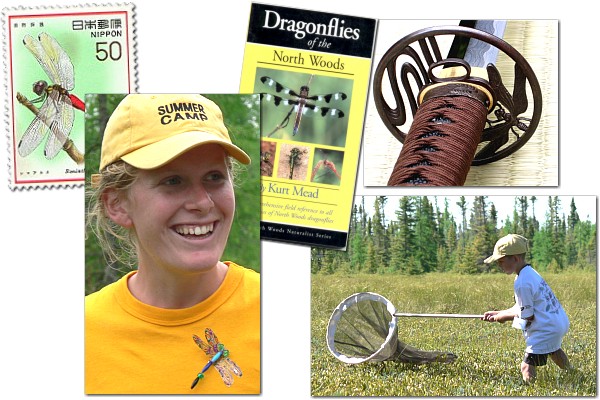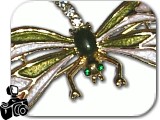| 
Dragonflies are popular insects today,
but they haven’t always been. In some European folklore,
dragonflies were associated with snakes and the devil. They
were called “the devil’s darning needles”.
Children were warned that if they were lying, a dragonfly
would come and sew up their mouth. The long abdomen of dragonflies
was mistakenly thought to be a stinger. Another common name
for dragonflies was “horse-stingers”.

In much of eastern Asia, people have always
liked dragonflies. Perhaps this is because they associate
dragonflies with their staple food, rice. Rice is grown
in water-filled fields called paddies, which are great habitat
for dragonflies.
 In
Japan, dragonflies are very popular. They are important
symbols in Japanese art and poetry. Samurai often used dragonfly
designs on clothing, helmets and swords. Another name for
Japan is “Akitsushima” which means “dragonfly
island”. Japan was the first country to establish
a dragonfly nature reserve, the Dragonfly Kingdom, in Nakamura. In
Japan, dragonflies are very popular. They are important
symbols in Japanese art and poetry. Samurai often used dragonfly
designs on clothing, helmets and swords. Another name for
Japan is “Akitsushima” which means “dragonfly
island”. Japan was the first country to establish
a dragonfly nature reserve, the Dragonfly Kingdom, in Nakamura.
In the legends of many
North American First Nations, dragonflies carry the spirits
of the dead. They share the butterfly’s symbolism
of immortality and rebirth. Dragonflies are thought to
parallel people as both come out of the water at birth
and neither can go back to being a water baby.
|
| 
 People
often think that some insects, like mosquitoes, flies and
termites, are “bad”, while others, like butterflies,
honey bees and dragonflies are “good”. Bad insects
bite us, damage our property or food and spread disease.
Good insects are beautiful to look at, help make our foods,
or eat the bad insects. But really, they are all just “insects”,
each kind trying to survive in its own way. People
often think that some insects, like mosquitoes, flies and
termites, are “bad”, while others, like butterflies,
honey bees and dragonflies are “good”. Bad insects
bite us, damage our property or food and spread disease.
Good insects are beautiful to look at, help make our foods,
or eat the bad insects. But really, they are all just “insects”,
each kind trying to survive in its own way.
Today, people seem to like dragonflies
for their beauty and their mastery of flight. “Dragonfly
watching” is now a popular pastime, aided by the many
books and web sites extolling the Odonata. Many people like
dragonflies because they eat insect pests, like mosquitoes
and horse flies. While this is true, it is important to
remember that dragonflies don’t have a big impact
on insect pest populations. [Refer back to: Mosquito
Control?]

 Evidence
that our modern society appreciates dragonflies can be found
everywhere. Dragonflies adorn all sorts of things: clothing,
wallpaper, jewelry, stamps, art work and commercial designs. Evidence
that our modern society appreciates dragonflies can be found
everywhere. Dragonflies adorn all sorts of things: clothing,
wallpaper, jewelry, stamps, art work and commercial designs.
Even in earlier times, when they may have
been less popular, dragonflies could still inspire people.
Alfred Lord Tennyson wrote "The Dragon-fly" in
1833:
Today I saw the dragon-fly
Come from the wells where he did lie.
An inner impulse rent the veil
Of his old husk: from head to tail
Came out clear plates of sapphire mail.
He dried his wings: like gauze they grew;
Thro' crofts and pastures wet with dew
A living flash of light he flew.
And here's some lyrics from a modern day
songwriter, Ziggy Marley, from his 2003 song "Dragonfly":
hey mister bee the world change but you remain
the same
and i wonder how you'll survive with the environment going
down the drain
hey miss dragonfly i see you look at me with your beautiful
eyes
you must be wondering what type of creature am i
|  Dragonfly
enthusiasts, or Odonatists, have come up with some
rather "inspired" names for their favourite
fliers. The Ebony Bog Haunter, Zigzag Darner, River
Jewelwing, Twelve-spotted Skimmer, Rusty Snaketail,
and Beaverpond Baskettail are all dragonflies found
in Manitoba. Dragonfly
enthusiasts, or Odonatists, have come up with some
rather "inspired" names for their favourite
fliers. The Ebony Bog Haunter, Zigzag Darner, River
Jewelwing, Twelve-spotted Skimmer, Rusty Snaketail,
and Beaverpond Baskettail are all dragonflies found
in Manitoba.
|
|